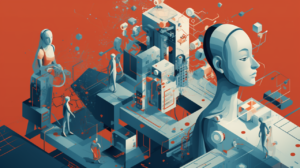The contemporary practices of design and innovation have ingrained the importance of customer focus. Whether in Design Thinking, Lean, Business Model Canvas, or even Agile, all of our frameworks, tools, and messaging have stressed the importance of understanding the customer experience and developing a customer-centric culture.
Companies are investing greatly in teaching everyone from sales people to line workers how to empathize with the customer and focus on their needs.
Customer focus is, of course, key to the organization, but the shift toward customer centricity has to start with HR. HR is the employee’s first and primary experience that proves whether the company actually values customer focus or just pays lip service to the buzzwords.
If HR does not model customer focus, how can we expect employees to adopt customer focus?
How your employees serve your customers is a complete reflection of how your employees are served by the company. If you want a responsive support department, a committed sales team and an innovative design team, then start with a responsive, innovative, committed HR.
“The most exciting breakthroughs of the 21st century will not occur because of technology, but because of an expanded concept of what it means to be human.” — John Naisbitt
HR is called to create the future
HR is the heart of an organization, but it has spent the past few decades mired in bureaucracy and administration. Hiring, firing, compensation, and risk mitigation have taken up much of the HR department’s bandwidth. Jobs and roles — not people — have been the focus, despite the reality that HR professionals generally entered the field to support humans, not to treat them like data points or functions in a supply chain.
We are in the middle of a massive shift toward the future of work, wherein organizations will become agile and adaptable networks.
HR has the opportunity and responsibility to put the human back in the center, and to become a strategic leader of organizational transformation.
Luckily, dramatic increases in the availability and quality of technology that automates the administrative work of HR is freeing the department to focus on the human.
The shifting context of the Future of Work
HR is at the nexus of multiple megatrends impacting how organizations create value in the future. Some of the key trends:
NEXT TECHNOLOGY DISRUPTORS: New technological advances (especially around AI) and externalized shared service offerings threaten to automate and entirely replace many of the current traditional HR functions.
SKILLING CHALLENGE: The Future of Work and exponential technological developments require massive re- and upskilling of the current workforce amidst a demographic and generational shift.
CHANGING BUSINESS STRUCTURES: More adaptable business structures require more flexible employment and even intrapreneurial equity/hire models.
AGILE HR: Faster organizational evolution will require more agile HR service offerings and a restructuring from a world of policies, guidelines and defined processes to an incessant focus on creating value for employees.
HR is also perfectly positioned to be a primary driver for the transformation required of the entire organization in order to thrive amidst radical change and uncertainty. Because HR has had the secret to success all along: put the human at the center.
The transition
HR technology providers are already creating solutions for better targeted recruitment, employee development and learning, employee self-service, in fraud and compliance, and even for employee well being (see Josh Bersin’s take on AI as a killer app for HR and these 11 Ways in which AI is transforming HR). HR is investing heavily in AI and embracing other digital trends like blind hiring, gamification, intelligent self-service tools, VR/AR, and managing the process of future-proofing a constantly learning and changing workforce.
Automating and outsourcing the core bureaucratic tasks of HR is important, but automation can only serve to free up the time and resources to focus on the real work of transformation.
Transformation in organizations has been slow or failing not because of a lack of technology, but because people default to old structures and narratives, and people lack the vision and capacities for transforming to a future culture.
How to get started
In order to shift toward customer focus and ingraining work tools of the future, it makes sense to approach the transformation of HR itself using the same tools we use to innovate for external customers. Persona development, business model canvas, and agile approaches serve us well in the development of new services for external clients; they also work for the internal client. Small, intrapreneurial teams can test innovative solutions in order to identify barriers and multipliers for change while delivering concrete and valuable results.
To learn more about taking a Customer Centric Approach to Transforming HR, Join Tirza at HR West or contact her at here.
ByTirza Hollenhorst Co-Written with philip horváth





